PiCAS
Hercules House
4 George Street
Gosport
Hampshire
PO12 4SY
Email: enquiries@picasuk.com
Skype: picas.uk
PiCAS is a company registered in England and Wales with company number 05206567
VAT No: 858 1204 26


|

|
|
Problem Birds
Pigeon
Roof-Nesting Gull
Mallard Duck
Greylag Goose
Canada Goose
Corvid Family
Starlings and Sparrows
Wood Pigeons and Collared Doves
This page is designed to give the reader a brief overview of the birds that most commonly cause problems together with photographs that will help identify the species in question. If you are experiencing problems with any species of wild bird PiCAS UK can help and if you do not see the bird on this page please contact PiCAS UK direct.
The Pigeon or Rock Dove (Columba livia)
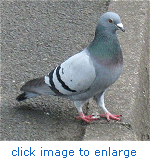
|
|
Breeding period: All year round
Nest: Rough nest made with twigs usually on or in buildings and never in trees
Number of eggs: 2 white eggs
Incubation period: 18/19 days
Fledging period: 25/32 days (up to 45 days in winter)
Food: Seed eater that will exploit multiple food sources including waste food in urban areas and deliberate feeding by the public.
|
The pigeon or rock dove is probably the most common urban species of bird that lives and breeds in close association with man. This is because the pigeon of today is an ancestor of the rock dove, a bird that was found living and breeding on cliffs around the coastline of the UK alongside gulls and other seabirds. This is why the pigeon of today is so superbly adapted to living in areas of human habitation where buildings that replicate cliff faces provide extensive predator-free roosting and breeding facilities. Not only this but also a ready food supply in the form of fast food refuse and large quantities of seed and other foodstuffs deliberately fed to pigeons by those who encourage their presence. It is a perfect environment for one of the most intelligent and adaptable birds on the planet. Although the commonly held view is that man domesticated the rock dove, in reality it is far more likely that the pigeon domesticated itself in order to exploit man. The pigeon is now found in every part of the world other than the two polar icecaps and this fact alone demonstrates how adaptable the species has become and how it rightly deserves its place as one of the most successful avian species of all time.
There is often a distinction made between the white dove and the city pigeon but the only difference is that the white dove has been bred for colour; the white dove and the pigeon are the same species, Columba livia. Many racing pigeon enthusiasts also make a distinction between the racing pigeon and the pigeon but, as with the white dove, the two birds are the same with the racing pigeon simply being bred for power and endurance.
Thousands of racing birds go feral each year, joining urban flocks of pigeons and breeding with their cousins. Many experts believe that this annual exodus of racing birds is fast becoming a major problem in urban areas as they join and burgeon the size of wild flocks.
Pigeons are commonly found roosting and breeding in roof voids and attic spaces with property owners often needing to exclude them and block up the entry/exit holes. It is important to be aware that because the pigeon breeds all-year round there is never a safe time to exclude birds when there will not be pigeon squabs (chicks) or flightless juvenile birds in situ. Blocking access holes may result in adult and flightless birds becoming trapped. Apart from the obvious humanitarian implications there are serious health and safety implications for the property owner concerned. If birds die as a result of having been sealed inside a void of any description the decomposing carcasses will become maggot-infested within a matter of days, particularly in summer months. There are also legal implications in respect of trapping live birds where property owners can be prosecuted for causing unnecessary suffering – please read The Law page for further information. Please contact PiCAS UK for advice before attempting to exclude pigeons from any type of enclosed space.
Attempts to control the pigeon using conventional means have failed completely as a result of the methods employed. The pest control industry is largely responsible for the massive global rise in pigeon numbers due to its excessive and commercially motivated use of lethal controls. Lethal controls have been used by the pest control industry for decades as a means of reducing pigeon flock size but this has only had the effect of increasing pigeon numbers and entrenching problems for property owners. This is because killing adult pigeons in a feeding flock favours the younger birds that would otherwise have a poorer chance of survival. The size of a pigeon flock is dictated absolutely by the extent of food available to it – if birds are physically removed from the flock, by culling for example, this not only increases the food supply for the remainder of the flock but creates a void into which surviving members of the flock breed. Culling or physical removal of pigeons by whatever means cannot reduce pigeon flock size.
The PiCAS group has pioneered highly effective methods of controlling pigeon populations by using non-lethal and holistic methods of control that deal with the source of the problem as well as the problem itself. These methods have resulted in a decline in the use of lethal controls worldwide and an acceptance that although the pigeon may be a nuisance, it is here to stay. We will never succeed in wiping out the species altogether and therefore tolerance and good working practices are the only means available to us to ensure that man and the pigeon can live alongside each other in relative harmony. The real enemies are the pest controller and the pigeon feeder because without lethal controls and the deliberate and persistent feeding of pigeon flocks, the pigeon would only exist in relatively small numbers and nothing like the problem it is currently perceived to be.
return to top of page

The Roof-Nesting Gull (Laridae)
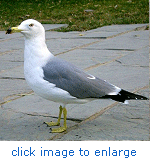
|
|
Breeding period: Between April and August depending on species
Nest: Substantial nest on cliff faces or on buildings in urban areas
Number of eggs: 2 to 3 eggs depending on species – normally olive/brown in colour
Incubation period: 24/28 days depending on species
Fledging period: 30/60 days depending on species
Food: Multiple food sources including waste food in urban areas (fast food refuse), waste on landfill sites, deliberate feeding by the public and natural food such as fish, invertebrates, molluscs etc.
|
The story of the gull is similar to that of the pigeon. Little more than a century ago most species of gull were confined to coastal areas breeding on cliffs and feeding exclusively in the sea and in estuary areas. Few birds strayed inland other than in bad weather. With the massive rise of fast food outlets and huge increase in landfill sites throughout the UK gulls have been encouraged inland to exploit these ready food sources. Not only this, but gulls have also seen the benefit of exploiting urban areas for the purposes of breeding. Man has provided the gull and the pigeon with optimum predator-free breeding facilities in the form of buildings, combined with easy and available food sources. Both species have also managed to exploit food from man that was not scavenged but which was deliberately fed.
The rise in complaints about gulls has increased dramatically over the last 20 years and this rise is completely in line with the greater availability of fast food and cheap food sources. Problems with gulls are most commonly connected with noise and soiling and where the birds breed on large flat roof areas in numbers. A vast majority of gull-related problems can be resolved quickly and easily by the property owner concerned acting solely on advice from PiCAS UK. Because most gull-related problems are confined to the breeding period, and because gulls always return to the same breeding site each year, once access to a breeding area has been blocked and the area protected with deterrents, the gulls will permanently move elsewhere.
As with the pigeon, the pest control industry has seen the benefit of trying to exploit this man-made problem, as has the media, with horror stories about gull ‘epidemics’ and the dangers to human health. Fortunately, however, the gull is a protected species of bird and pest control companies cannot use highly profitable lethal controls on gulls as they do to excess with the pigeon. As a result the numbers of gulls currently occupying urban areas is still low, certainly relative to the pigeon, and other than in coastal areas gull-related problems are mainly confined to the breeding period.
Gulls can be controlled very effectively and without using any invasive control techniques commonly employed by the pest control industry. Individual buildings can be protected comprehensively by using a combination of deterrents and anti-roosting products and alongside complimentary controls such as egg-oiling, which can be considered for areas where gulls are breeding in numbers. There are numerous control options for gulls, most of which are highly effective and relatively inexpensive to provide, but as with any type of bird control system a holistic approach is extremely important. In order to control gulls effectively an understanding of the species is vitally important and therefore advice must always be sought from a bird control expert rather than a pest control company. Pest control contractors know little or nothing about the habits of gulls and how the species will react and respond to the controls provided. This, combined with the fact that contractors have a vested interest in selling products and installation services, renders any advice provided by a pest control contractor extremely questionable at best.
return to top of page

Mallard Duck (Anas platyrhynchos)
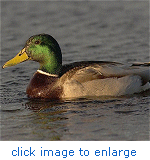
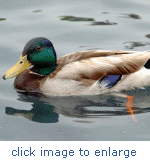
|
|
Breeding period: Between March and June/July
Nest: Substantial nest, usually on the ground (under hedges for example) but can be found high in trees
Number of eggs: 9-13 eggs, bluish-green in colour
Incubation period: 27/28 days
Fledging period: Up to 60 days
Food: Opportunistic feeder exploiting multiple natural food sources with deliberate feeding by the public being the most common food source in areas of human habitation
|
Although many species of duck cause problems in urban areas (also small towns and villages with ponds) it is the mallard duck that is the most commonly controlled species. It is only in the last 20/30 years that ducks have been starting to cause problems in areas of human habitation, in the main due to overfeeding by the general public. Therefore, a majority of so-called duck problems are, in reality, human problems and must be dealt with as such. The increase in the size of urban and semi-urban duck populations has also coincided with the greater availability of cheap food sources via value lines in supermarkets. Increased competition between supermarket chains has further entrenched the problem with everyday foods like cheap white bread (the food most commonly offered to waterfowl) falling as low as 15p a loaf.
Duck populations in some inner city areas, and on many village ponds, have risen to levels far above that which the natural infrastructure is able to support. The quality of pond water often reduces to the point where all natural water-life disappears and grassy areas around ponds turn into mud with fouling by ducks and geese compounding the problem. At this point calls for the birds to be culled are common, mainly from residents (many of whom feed the ducks), the media and the pest control industry. It is rare, however, for ducks to cause any type of problem other than compromising water quality in ponds and ‘paddling’ grassy areas where they are fed. As overpopulations of mallard ducks are virtually always due to human overfeeding, a degree of tolerance and common sense must always be used when attempting to control their numbers.
As with virtually all species of bird and waterfowl, culling is completely ineffective as a method of control and in most cases culling simply encourages breeding, resulting in an increase in bird numbers, not a reduction. Culling deals with the problem itself, not the source of the problem. In order to deal with annual increases in the number of ducks in urban and semi-rural areas the problem must be dealt with at source and the problem is always deliberate and persistent overfeeding by the public. Like the pigeon, ducks have learned to exploit man for food and they do this very effectively. Parents enjoy taking their children to feed ducks on the lake in the local park or on the village pond at the weekend and yet it is not unusual to see huge quantities of uneaten white bread floating on the water, far more than will ever be consumed by waterfowl. What happens to this bread? It stagnates the water, encourages ducks and geese to breed more frequently and encourages rats. However, the same people that take their children to feed ducks in the park will readily complain about duck overpopulations and call for the birds to be culled if numbers grow too fast, particularly if there is a perceived risk to their children’s health.
The only effective means of reducing duck numbers in urban and semi-rural environments (and the species rarely ever causes problems in its natural habitat) is to educate the public not to feed the birds and make clear the links between feeding and overpopulations. With hard-hitting public education programmes in place combined with natural eco-controls such as egg oiling, duck populations will reduce rapidly and without the need to resort to any type of invasive control. PiCAS UK specialises in the provision of holistic waterfowl management programmes.
return to top of page

Greylag Goose (Anser anser)
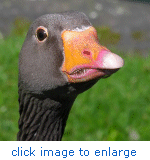
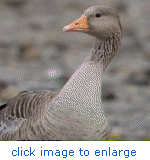
|
|
Breeding period: Between April and June/July
Nest: Substantial nest, usually on the ground in sheltered areas or in reeds
Number of eggs: 4-6 eggs, creamy-white in colour
Incubation period: 27/28 days
Fledging period: 50/60 days
Food: Opportunistic feeder exploiting multiple natural food sources such as grass, grain and cereal crops but deliberate feeding by the public is the most common food source in areas of human habitation.
|
The greylag goose rarely causes problems in its natural habitat although the species is commonly slaughtered in large numbers during rough shooting events (blood sports) for the purposes of pleasure. The species has, however, learned to exploit ready food sources in urban and semi-rural areas in recent years and they are now a more common sight in public parks and on village ponds feeding alongside ducks and other waterfowl. Due to their physical size, however, the presence of the greylag is tolerated less readily than that of the duck. Whereas the duck will spend much of its time on water when feeding the greylag will spend more time out of the water and therefore fouling inevitably becomes an issue. The bird is often accused of being aggressive toward children but this is simply another by-product of public feeding – the birds associate humans with food and, understandably and inevitably, fail to differentiate between children and adults. What is perceived to be aggression is simply enthusiasm to exploit ever more food.
As with the mallard, the only effective means of reducing greylag numbers is to educate the general public not to feed the birds and for local authorities to take a proactive stance where the issue of public feeding is concerned. A regime of breeding controls such as egg-oiling are also recommended in order to reduce flock size at the same time as reducing available food.
return to top of page

Canada Goose (Branta canadenis)
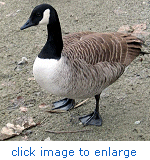
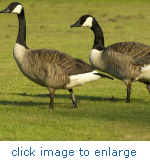
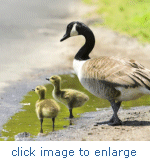
|
|
Breeding period: Between April and June
Nest: Substantial nest on the ground often below trees or bushes and near water. Also in sheltered areas or in reeds
Number of eggs: 5-6 eggs, creamy-white in colour
Incubation period: 25/28 days
Fledging period: 42/63 days
Food: Multiple natural food sources such as short cropped grass (main natural food source), stems and leaves, waterside plants and deliberate feeding by the public.
|
The Canada goose has become a major problem in both agricultural areas and in urban areas in recent years based on its ability to settle almost anywhere providing that there is sufficient food and infrastructure to support it. In the late 1960’s there was an estimated population of over 10,000 birds in Britain and the figure has increased every year since. Although the Canada goose is a highly migratory bird static populations are quickly growing in size throughout the UK due to a combination of changes in climate (warmer winters) and the availability of extensive food sources in both urban, semi-rural and rural areas.
The Canada goose is killed in ever-growing numbers by farmers, sportsmen and the pest control industry in an effort to reduce flock size, but lethal control completely fails to deal with the problem. Many landowners now actively encourage and feed Canada geese on private estates and in their natural breeding grounds in order to bolster bird numbers. This is done to increase the variety and number of wild birds available to ‘guns’ during rough shooting events. Although the motivation is purely commercial and the action strictly illegal (to encourage a pest species and then kill it for sport using the General Licences) it inevitably has the effect of increasing numbers of Canada geese throughout the UK with resultant implications for property owners in urban areas. As a result of the wholesale slaughter of Canada geese in rural areas the bird is quite naturally starting to move into urban areas in an attempt to identify both breeding and feeding areas in a less dangerous environment. This has led to a sharp increase of Canada geese causing problems in city centre parks and on ornamental lawns and gardens where acres of close cropped grass provide the birds with open-ended quantities of its preferred food. Not only this, but as with the mallard duck and greylag goose, the Canada goose has adapted its diet to include large quantities of deliberately fed food such as white sliced bread from the general public.
Of all the species of waterfowl the Canada goose is the most difficult to control based on its preparedness to move from one area to another to exploit food and good breeding sites. Control regimes are complex and must be multi-faceted, but can be extremely effective providing that effort is made to understand this commonly misunderstood bird. A combination of public education and breeding controls in urban areas, and the provision of breeding controls in rural areas, will resolve a vast majority of problems associated with this bird. PiCAS UK specialises in the provision of holistic and effective control programmes for the Canada goose.
return to top of page

The Corvid Family (Corvidae)
Magpie, Hooded Crow, Rook, Jackdaw
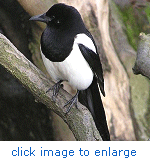
Magpie
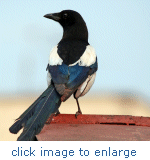
|
|
Breeding period: Between March and July depending on species
Nest: Substantial nest of twigs provided high in trees, with the exception of the jackdaw that will sometimes nest on buildings and particularly in chimney pots. Rooks often breed in large colonies.
Number of eggs: 3-6 eggs depending on species
Incubation period: 15/20 days depending on species
Fledging period: 26/33 days depending on species
Food: These birds are omnivorous and will eat virtually any food. Magpies in particular have a reputation for taking the chicks of other species of bird.
|
Hooded crows and jackdaws are mainly associated with problems in rural areas and, like the wood pigeon, are slaughtered in huge numbers mainly for the purposes of sport but under the guise of control and illegally using the General Licence system. Rooks are commonly associated with crop damage and although they will take grain where and when they can get it, worms and leatherjackets form a large part of their diet and damage to crops is wildly exaggerated. Crows are also blamed for attacking lambs but this rarely ever happens and the real reason they are not tolerated by farmers and landowners is because they eat the eggs of game birds. Breeding game birds for the purpose of shooting them for pleasure is a fast growing industry in the UK - anything that gets in the way of the farmer or landowner that sells these services is slaughtered out of hand. Methods used to kill crows include the use of poisons (although illegal), shooting and cage-trapping using Larsen traps.
Rooks breed in large colonies or rookeries where hundreds of birds can be seen nesting high in trees, normally in villages and on the outskirts of small towns. Flocks of feeding rooks can number many thousands and the main problem associated with the rook is noise from rookeries in the breeding period. Noise can start as early as 4 a.m. and in large rookeries can be quite extreme – evenings are also a noisy time. There are numerous methods of humanely and holistically controlling rook populations but the most common method of control is shooting by overenthusiastic gun-happy rural residents combined with the removal of nests. In both cases there are legal implications associated with the use of lethal controls for this species and penalties can be severe if lethal control is used inappropriately. Lethal control, however, when used to control virtually any species of wild bird will rarely resolve the problem and more often than not will further entrench the problem.
The magpie is now becoming a common sight in urban gardens but was once almost exclusively a rural bird. As with so many species of bird that are now becoming a problem in urban areas, the exodus from rural environments is due to almost exclusively to the excessive use of lethal controls such as shooting and cage-trapping and killing. The magpie is most commonly associated with taking the chicks of protected birds and has received a bad reputation as a result. The perception of the magpie as the bad guy is misplaced however – taking chicks to feed its young is the magpie’s main natural food source during the breeding period and it is just human sensibilities that are offended by this natural predation. The irony is that many of the most vociferous complainants of the magpie’s predatory habits are those who own domestic cats; the domestic cat is a voracious predator and kills far more protected birds, and their chicks, than the magpie ever does. Hawks and falcons also take many more protected birds each year to feed their young than magpies do. Farmers and landowners slaughter magpies in huge numbers using shooting, poisoning (although illegal) and cage-trapping with Larsen traps because they take the eggs and chicks of game birds. Most of the rural methods used to control magpies commonly cause unnecessary suffering, however, few if any farmers or landowners are ever prosecuted for cruelty with organisations like the RSPCA,
DEFRA and Natural England ‘turning a blind eye’.
The jackdaw is only ever a problem when the bird builds a nest in a chimney pot, a common breeding opportunity for this species. Blocked chimneys can be dangerous and therefore it is wise to protect chimneys against this problem. The bird rarely ever causes any other type of problem in urban areas.
return to top of page

Starling (Sturnus vulgaris) House Sparrow (Passer domesticus)
Starling
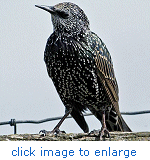
Sparrow
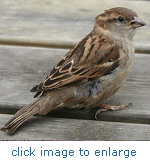
Starling
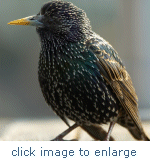
|
|
Breeding period:
Starling – Mid April to June
Sparrow – April to September
Nest:
Starling – mainly in roof voids or a hole in a building but sometimes in trees
Sparrow – mainly in roof voids or a hole in a building but sometimes in hedgerows. Three broods annually with an increasing trend toward all-year round breeding.
Number of eggs:
Starling – 5-6 blue eggs
Sparrow – 3-7 greyish eggs
Incubation period:
Starling - 12/15 days
Sparrow – 13/15 days
Fledging period:
Starling – 19/22 days
Sparrow – 15/17 days
Food:
Starling – seeds, fruit, caterpillars, leatherjackets and ants
Sparrow - seed eater that will exploit many different food sources including buds and insects
|
Both these species have been historically connected with causing problems to property owners during the breeding period but today both species are in decline in urban areas and the decline of the house sparrow is of particular concern. Both species can breed in trees or hedgerows but most commonly build nests in roof voids where they are perceived to be a problem. In reality neither bird causes any type of problem in a domestic property where their presence has little if any impact. Even in light of this many people worry about birds nesting in their attic spaces and undertake crude and potentially illegal hole-blocking exercises which result in fledglings being sealed into roof spaces alive. This is illegal and penalties can be severe. Nests of starlings and sparrows cause no damage other than a few twigs in the roof void – both species will only occupy a roof void or soffit for a few months until their young are fledged. No smell is associated with their presence and contrary to advice provided by the pest control industry birds do not harbour diseases which can be transmitted to humans.
The only areas where sparrows and starlings can cause problems is where they are roosting or breeding in food preparation or food storage areas. Health and safety legislation is strict in relation to hygiene in these environments and the presence of birds is rarely tolerated. Both species are small and can access very small gaps in brickwork in order to gain entry to these areas. There are numerous completely humane and effective methods of excluding these species but, incredibly and even in light of their dwindling numbers, pest control contractors still commonly recommend lethal controls.
Historically starlings have caused major soiling problems purely due to their roosting habits on or within buildings, resulting in major soling problems. Starlings are a flock bird and can roost in very large numbers, mainly in railway stations, historic buildings and Victorian style factory buildings at particular times of the year. In recent years this type of problem has reduced dramatically with relatively few cases being reported. Humane control options are straightforward and very effective but lethal controls are completely ineffective.
return to top of page

Wood Pigeon (Columba palumbus) Collared Dove or Ring Necked Dove (Strepopelia decaocto)
Wood Pigeon
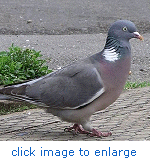
|
|
Breeding period:
Wood pigeon – June to November but it is common for this species to breed much earlier in the year, particularly in urban areas and due mainly to warmer winters and greater availability of food sources
Collared dove – March to October but the species can breed all-year round
Nest: Rough nest made with twigs usually in trees. Wood pigeons tend to build nests on the extremity of branches where the foliage is thickest and collared doves favour nesting sites closer to the trunk of the tree. The nests of both of these birds are very flimsy.
Number of eggs: 2 white eggs
Incubation period: 16/17 days
Fledging period:
Wood pigeons – 33/34 days
Collared dove – 17/19 days
Food: Seed eater that will exploit multiple food sources including berries, buds, and fruits. Human feeding is becoming a mainstay for both species, mainly in urban gardens.
|
Collared Dove
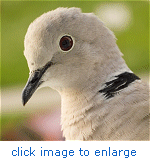
|
Collared Dove
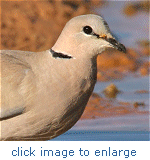
|
Wood Pigeon
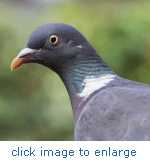
|
Wood Pigeon
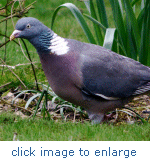
|
The wood pigeon is another of the rural refugees that has started to move into urban areas to find harbourage from the pursuit of rural blood sports. Wood pigeons are shot in their hundreds of thousands all year round by farmers and landowners, mainly for sport and pleasure but in the guise of control. The wood pigeon is a rural bird that can be seen in huge numbers feeding in fields of crops and vegetables. Although it is commonly known that their numbers cannot be reduced by the use of lethal control, farmers and landowners actively encourage wood pigeon onto their land to bolster bird numbers for commercial shoots. Rough shooting and organised game shooting is a huge business in the UK with wood pigeons and members of the corvid family being highly valuable assets for anyone selling blood sports of this nature.
Wood pigeons in rural environments can be controlled, to a degree, using non-lethal methods but scaring is only a temporary solution, simply moving flocks from A to B. Lethal controls are totally ineffective so in many respects we must learn to live with the wood pigeon and tolerate its presence.
Wood pigeons commonly cause problems in domestic gardens as a result of both roosting and breeding and PiCAS UK receives large numbers of enquiries about their control throughout the breeding period. Complaints are generally centered around noise (from cooing in the early morning when involved in breeding displays) and excrement falling to garden and patio/decking areas from roosting and breeding activity in trees above. There are many non-lethal and effective means of resolving these problems but each control provided has to be specific to the problem that is being experienced and more importantly, where it is being experienced. Wood pigeons are even starting to move into inner city areas to escape persecution in rural areas and can become a problem for some city centre property owners if the birds start to breed in flower planters or flower boxes provided on the frontage of commercial buildings. These problems can be easily resolved acting on advice from PiCAS UK. PiCAS UK will advise any property owner through its unique telephone consultancy service how best to resolve any type of wood pigeon-related problem be it in a domestic garden or on residential or commercial property.
The Collared dove rarely causes problems as a result of roosting or breeding as they are a much smaller bird than the wood pigeon, but they are commonly associated with noise-related problems. Collared doves are a relatively recent sight in UK towns and gardens having been introduced to Britain in the 1950’s. They have been a highly successful species exploiting bird tables and making themselves very much at home in the domestic garden. As with the wood pigeon however, their control can be difficult but in most cases collared doves can be controlled humanely and effectively by providing a combination of anti-roosting products and
holistic control options.
return to top of page
Pigeon
Roof-Nesting Gull
Mallard Duck
Greylag Goose
Canada Goose
Corvid Family
Starlings and Sparrows
Wood Pigeons and Collared Doves
|
|
|

|
|
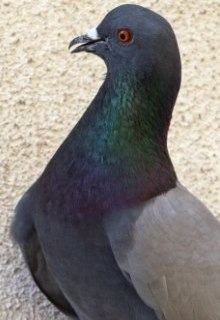
The PiCAS Group will provide advice on the control of any bird species. Advice is most commonly sought for problems relating to the following:
Pigeon or Rock Dove: Pigeons are never more at home than when roosting and breeding on buildings in urban areas and as a result they are the most commonly controlled species of bird on the planet. Conventional pest control options such as lethal control has simply acted to increase pigeon numbers, not reduce them. The PiCAS Group has specialised in pigeon control for decades, researching and designing effective and sustainable pigeon control systems and as a result is now considered to be the foremost authority on the subject worldwide. PiCAS will provide advice on the protection of individual buildings and sites through to the provision of area-wide pigeon control systems for local authorities.
Gulls: Gulls have historically caused problems for property owners in towns and cities close to coastal areas but now many species of gull, including herring gulls, black headed gulls and black backed gulls are becoming common in many inland urban areas. These species are commonly known as roof-nesting gulls. Effective gull management systems are complex and to be effective they must be holistic and deal with the source of the problem as well as the problem itself. PiCAS will advise on all aspects of humane but effective gull control.
Ducks and Geese: Ducks and geese are a growing problem throughout the UK in villages, towns and even city parks with deliberate and persistent feeding of the birds being the root cause of the problem. Duck control and goose control is never straightforward and can be a highly public and emotive issue. PiCAS has extensive experience of providing humane but effective duck and goose management systems for councils, property owners and site managers throughout the UK.
Canada Geese: This species is starting to cause major problems for property owners and site managers throughout the UK. As with most waterfowl controls, Canada goose control systems are complex and must be holistic. PiCAS has extensive experience of controlling Canada goose populations, whether they be static or migratory, and will tailor a Canada goose control programme to the specific needs of the client.
Starlings and Sparrows: Although starlings were a common problem in town and city centres worldwide during the 1960’s and 1970’s, fewer problems are now being reported. However, where starlings do roost in large numbers problems can be extreme and PiCAS will provide any property owner with a tailor-made starling control system.
Sparrow populations are in rapid decline and as a result fewer sparrow-related problems are being reported. Sparrows do sometimes cause problems in food production plants and food preparation facilities however. Sparrow control is rarely simple or straightforward due to the fact that these small birds can easily access roof voids or internal areas due to their size. PiCAS will provide advice on humane but effective sparrow control.
Wood Pigeons and Collared Doves: These species are more complex to control and are more commonly associated with rural areas. Both species are now becoming more common in urban areas where they can cause problems for residential property owners. Control options for these species are limited but PiCAS will offer advice where both wood pigeon control and collared dove control is concerned.
Rook, Magpie, Jackdaw and Hooded Crow (Corvids): These species commonly cause problems in both urban and rural areas and can be complex to control. Rook control and Crow control options are usually limited to rural areas where they are perceived to cause crop damage and predate on livestock in the case of crows, but nuisance is exaggerated. Rooks often breed in rookeries and can cause significant disturbance as a result of noise. Magpie control is more commonly sought in urban areas due to their growing presence in domestic gardens as a result of persecution in rural areas. Jackdaws rarely cause problems other than nesting in chimney pots and therefore jackdaw control is extremely straightforward. All members of the Corvid family can be controlled effectively using non-lethal and holistic controls.
|